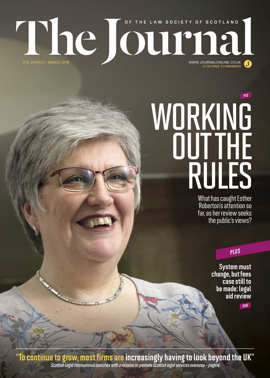Application changes coming

Last month, February, the Registers of Scotland (Digital Registration etc) (Scotland) Regulations 2018 were approved by members of the Scottish Parliament, before being signed into law by the Cabinet Secretary for the Economy, Jobs, and Fair Work, Keith Brown. The regulations will facilitate the introduction of new digital services provided by RoS and provide for a presumption in favour of the use of these digital services, as well as enable changes to the land registration application form.
We are making several improvements to our Land Register application form in line with the new regulations. The changes are specifically designed to reduce rejections and increase efficiency in this important process. Many thanks to members of our user experience panel who participated in user research on these changes.
We are removing the signature requirement on the application form, introducing a new title information section, updating the Servitudes and Burdens sections, and streamlining the printed form.
Removal of signature requirement
Current figures show that a significant number of applications are rejected because the form hasn’t been signed. We know that rejections remain a source of frustration for our customers and we are always looking for ways to reduce their number. With the new legislation, there is no need for the form to be signed, removing this frequently missed administrative stage of the process.
Removing the Certification in relation to links in title section
As part of our efforts to streamline our processes, we’ve merged the Title Examination and Certification in relation to links in title sections, and named the new section Title Information. The changes in this section can be summarised in a few key points.
First, the section itself only appears in applications for title transfers over unregistered land, so it won’t be applicable for every application. We’ve also completely removed the certification of links in title question, as there is often confusion over its relevance and whether to complete it which ultimately leads to rejections. And finally, we’ve changed the prescriptive claimant part of this question slightly, with the content remaining the same but its format split into two, more easily understood parts. This will improve clarity and make the question easier to answer accurately.
Servitudes and burdens
We’ve reworded the questions to make it easier for you to be confident that the information provided is the information we need.
The new approach is based on a very simple rule: RoS will include in the title all servitudes and burdens that are contained in the deed being registered, unless we’re advised otherwise by the applicant.
Improving user experience
We’ve also used these changes as an opportunity to introduce overall usability improvements to the printed PDF generated via our eForms service, making it more responsive to the particular information entered. This results in a shorter and more readable form, which boosts overall efficiency.
Transition period
We are conscious that many transactions span several weeks or months, so there will be some crossover between the old form and the introduction of the new. As such, we will continue to accept the old form for three months after the implementation date.
For draft eForms that have been saved but not submitted to RoS prior to the implementation date, where relevant, you will be prompted to re-answer the Servitudes and Burdens sections and the new version of the form will be generated on submission. If your application is for title transfers over unregistered land, you’ll also be prompted to re-answer the questions in the new Title Information section. For other application types, this section will be removed.
We continually review our processes to ensure efficiency for our customers – you can find out more at www.ros.gov.uk
New feature for ScotLIS
As 2018 continues apace, so too do the ongoing improvements that RoS is making to ensure that Scotland has the best possible land registration services.
ScotLIS has a new feature, which means business users can now reset their password directly through ScotLIS. This new chosen password will then work for all RoS digital services accessed through an online services account. The introduction of this feature is based on customer feedback, and allows users to reset passwords without the need to contact RoS customer services.
Using the new feature is easy. Simply click “Forgotten your password?” at the sign-in page. You then just need to provide your username, and an email with a reset link will be sent to the associated email address. This link is valid for two hours, and once you reset your password you’ll receive a notification email that the change has been successful. We are working towards making sure ScotLIS is as user-friendly as possible, and welcome your continued feedback.
In this issue
- Borrowings, partner capital and profitability
- GDPR and the cloud
- Employment claims: is the flood still to come?
- Contributory fault: drivers, cyclists and pedestrians
- Reading for pleasure
- Opinion: Derek McCabe
- Book reviews
- Profile: Siobhan Kahmann
- President's column
- Application changes coming
- People on the move
- Seeking a better way
- Beyond borders
- Drawings and profitability
- Enforceable rights or progressive policy goals?
- Conflict theory: it works
- What the liquidators don't tell you
- The office on the move
- Please can we have some more?
- Health check for doctors' lines
- When creditors come first
- Keeping goods exclusive
- Tenant Farming Commissioner: the story so far
- HSE appeals: experts allowed in
- Scottish Solicitors' Discipline Tribunal
- Please don't stop the music
- Broadcasting's business end
- Public policy highlights
- Scam warnings escalate
- This time it's personal
- The game's not a bogey!
- "Only amateurs attack machines; professionals target people"
- When estate agents need client ID
- Banks, client accounts and the Money Laundering Regulations
- Third party rights: what now?
- Ask Ash






